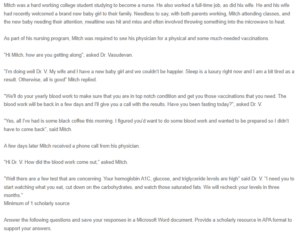Case Study – Chemical Composition and Health Implications of Carbohydrates and Fats
Chemical Relationship Between Carbohydrates and Fats
Carbohydrates and fats are both macronutrients essential for the body’s energy needs. Chemically, they are related through their role in providing fuel for cellular activities. Carbohydrates comprise carbon, hydrogen, and oxygen, forming sugar molecules, which can be broken down into glucose for energy (Blanco & Blanco, 2022; Katzung et al., 2021). On the other hand, fats consist of carbon, hydrogen, and oxygen but in different molecular structures. Fats are triglycerides comprised of glycerol and three fatty acid chains. Both carbohydrates and fats are energy sources; excess calories can contribute to weight gain and related health issues.
Saturated vs. Unsaturated Fats
Saturated fats are commonly found in animal products and specific plant oils that can be solid at ambient temperature. The carbon atoms are linked by single bonds in their fatty acid chains. However, unsaturated fats are liquid at room temperature due to one or more double bonds between the carbon atoms(Blanco & Blanco, 2022; Katzung et al., 2021). Mitch was cautioned against consuming too much-saturated fats as doing so raises cholesterol and the risk of cardiovascular illnesses. Since unsaturated fats can help allay detrimental cholesterol levels and decrease the risk of heart disease, they are seen as better alternatives—monounsaturated and polyunsaturated fats, in particular.
Advantages of Consuming Unsaturated Fats
Consumption of unsaturated fats instead of saturated fats is advised since they are better for heart health. Low-density lipoprotein (LDL) cholesterol levels can be lowered by unsaturated fats, which is advantageous for cardiovascular health (Katzung et al., 2021). Additionally, they can raise HDL (high-density lipoprotein) cholesterol, which helps prevent heart disease. Consuming foods high in unsaturated fats, such as avocados, almonds, and olive oil, helps to maintain a healthy lipid profile and general well-being.
Trans-Fats
Trans-fats are synthetic fats produced by adding hydrogen to liquid oils to solidify them (Blanco & Blanco, 2022; Katzung et al., 2021). This process is known as hydrogenation. Foods may include trans fats, which companies add to enhance flavor, texture, and shelf life. Nonetheless, because trans fats raise the risk of cardiovascular illnesses, regulations are being implemented to reduce their availability in processed foods.
Potential Physical Conditions from Elevated Triglyceride Levels
Mitch might be in danger of a number of illnesses if he does not lower his triglyceride levels. An increased risk of pancreatitis, atherosclerosis, and cardiovascular illnesses is linked to elevated triglycerides (Katzung et al., 2021). Atherosclerosis is a condition in which blood vessels harden and narrow, limiting blood flow and perhaps increasing the risk of heart attacks and strokes. Additionally, persistently taking high triglyceride levels can contribute to metabolic syndrome and type 2 diabetes, emphasizing the importance of dietary changes to manage these health risks.
References
Blanco, A., & Blanco, G. (2022). Medical biochemistry. Academic Press.
Katzung, B. G., Kruidering-Hall, M., Tuan, R. L., Vanderah, T. W., & Trevor, A. J. (2021). Katzung & Trevor’s pharmacology examination and board review (13th ed.). McGraw Hill Professional.
ORDER A PLAGIARISM-FREE PAPER HERE
We’ll write everything from scratch
Question
Mitch was a hardworking college student studying to become a nurse. He also worked a full-time job, as did his wife. He and his wife had recently welcomed a brand new baby girl to their family. Needless to say, with both parents working, Mitch attending classes, and the new baby needing their attention, mealtime was hit and miss and often involved throwing something into the microwave to heat.

Chemical Composition and Health Implications of Carbohydrates and Fats
As part of his nursing program, Mitch was required to see his physician for a physical and some much-needed vaccinations.
“Hi Mitch, how are you getting along”, asked Dr. Vasudevan.
“I’m doing well Dr. V. My wife and I have a new baby girl and we couldn’t be happier. Sleep is a luxury right now and I am a bit tired as a result. Otherwise, all is good” Mitch replied.
“We’ll do your yearly blood work to make sure that you are in top notch condition and get you those vaccinations that you need. The blood work will be back in a few days and I’ll give you a call with the results. Have you been fasting today?”, asked Dr. V.
“Yes, all I’ve had is some black coffee this morning. I figured you’d want to do some blood work and wanted to be prepared so I didn’t have to come back”, said Mitch.
A few days later Mitch received a phone call from his physician.
“Hi Dr. V. How did the blood work come out,” asked Mitch.
“Well there are a few test that are concerning. Your hemoglobin A1C, glucose, and triglyceride levels are high” said Dr. V. “I need you to start watching what you eat, cut down on the carbohydrates, and watch those saturated fats. We will recheck your levels in three months.”
Minimum of 1 scholarly source
Answer the following questions and save your responses in a Microsoft Word document. Provide a scholarly resource in APA format to support your answers.
1 How are carbohydrates and fats related to each other chemically?
2-Mitch was told to watch his saturated fats. What is the difference between a saturated and an unsaturated fat?
3-Why is it better to consume unsaturated fats over saturated fats?
4-If you look at food packaging you may see the word trans-fat. What is a trans-fat, how is it made, and why would companies want to add trans fats to their foods?
5-If Mitch doesn’t decrease his triglyceride levels, what types of physical conditions may develop?

